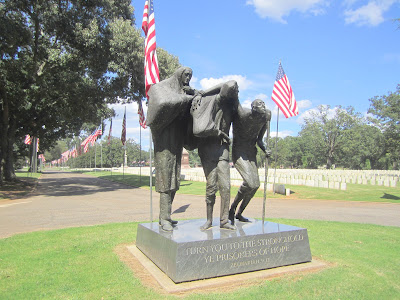Midway through the Civil War, General U.S. Grant surmised that the Confederate prisoners of war he had been trading for Union prisoners were showing up again on the battlefields and replenishing the severely stressed southern army. That realization led Grant to refuse to trade any more prisoners of war with the South.
Both sides were capturing so many soldiers by then that prisoner-of-war camps had to be built to hold them all. It was then that Fort Sumter near the town of Andersonville was born.

The Andersonville prison opened in February of 1864 just a few miles south of Atlanta, and at its peak covered 26 acres and housed 45,000 Union soldiers. 13,000 of those prisoners died and were buried at this site before the war ended 14 months later.
(Imagine if you can, a community of 45 thousand men occupying the space of the average Super Walmart store and parking lot.)

The tranquility of the area was deceiving...

A prisoner described his entry into the prison camp this way:
"As we entered the place, a spectacle met our eyes that almost froze our blood with horror and made our hearts fail within us. Before us were forms that had once been active and erect...stalwart men; now nothing but mere walking skeletons, covered with filth and vermin.....

......In the center of the whole was a swamp, occupying about three or four acres of the narrowed limits, and a part of this marshy place had been used by the prisoners as a sink--and excrement covered the ground, the scent arising from which was suffocating."
(Those monuments on the hilltop were the center of the camp. The small drop at the foot of the hill was the site of the only water supply.)

"Our new camp was on two steep hillsides, at the base of which was a great quagmire. This was ditched through the center with a narrow, shallow stream, which was very sluggish on account of the small supply of water and the slight descent of the ground."
Charles C. Fosdick, 5th Iowa Infantry, Feb. 26, 1964

And, as evidenced in many of the pictures that were taken of the area, the shelters were rudimentary and only available for a small number of the men.

Just imagine the heat of a Georgia summer, the smell of the sink, the flies, mosquitoes, no food, no water and minimal clothes....

But the reality hit me the hardest at the cemetery....

This cemetary lies deep in the heart of the south, 50 miles below Atlanta, yet there is only one confederate soldier buried here--all the rest were Union soldiers.

The prisoners' headstones are only inches apart. As the death rate at Andersonville escalated to 100 per day, officials abandoned the use of pinebox coffins and had the bodies buried shoulder to shoulder in trenches.

"If a man died in good clothes he was buried nearly naked. The living needed apparel; the dead none."
G.E. Reynolds, 86th Ohio Infantry, August 3, 1864

At first only numbered stakes marked the prisoners' graves. The dead might have remained unidentified except for the efforts of Dorence Atwater, a former prisoner.
Prison officials assigned Dorence Atwater to keep records of the dead. Hoping to notify bereaved relatives after the war, Atwater made a second copy of the death list, which he smuggled out in the lining of his jacket. When he accompanied Clara Barton (the nurse) to Andersonville in July 1865, they were able to match his list with the numbered stakes. Each prisoner could then be honored by name.
(from Historical Marker)

After the war there was a trial for Captain Wirz, the southern officer in charge of Fort Sumter prison camp. He was found guilty of conspiracy and murder and was executed.
(I hope this is my last visit to a Civil War site. But I thought this was too revealing not to include it in this blog)
"The Civil War was the defining event in United States history. The war brought an end to slavery and established the Union as perpetual. The costs were devastating: 620,000 deaths and billions of dollars. War brought widespread destruction, especially in the South, where most of the fighting occurred. The Civil War and its legacy continue to shape American life today. Each generation must come to terms with this great rupture in the national past."





Toni,
ReplyDeleteA good subject for thought. I've never been there, but have read about it. You manage to evoke the horror and sadness, and the great irony of such an awful and deadly struggle within our country. And in such a currently beautiful setting.
Thanks.
Lynda
Brutal place
ReplyDelete. Too bad the war did not define to the US not to engage in another.....
The prison camp at Andersonville was named Camp Sumter, after Sumter County, in which it is located, not Fort Sumter. Fort Sumter, named after Revolutionary War hero General Thomas Sumter, is located in Charleston Harbor, SC. Its a common enough error.. just trying to help, not criticize.
ReplyDeleteRobert W. Hughes
Savannah GA